Home
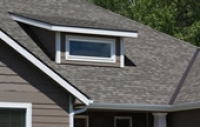
ROOFING IS MY JOB.....HONESTY IS MY PRODUCT
Roofing.
The word can send chills racing down your spine with images of contractors stalking across your property speaking a form of gibberish. How do you find a reliable contractor amidst a group of strangers? How many times will that project estimate change before the project is complete? How long will your home be in a state of disruption?
Before you start thumbing through the phone book, let
"Rod the Roofer" (506) 461-1252
help inform you about the realities of a roof project and what you need to know when you hire a roofing contractor.
Do you need a new roof?
It can sometimes be tough to determine just why your inspector says a new roof is necessary, but there are a few simple signs to look for.
We do not recommend that you inspect your roof by walking across it . Instead, start by taking a pair of binoculars with you into the yard, find a spot without trees or other buildings blocking your view and look for any of the following signs:
Outside Roof Inspection Checklist
Curled Roof Shingles
Split Roof Shingles
Missing Shingles 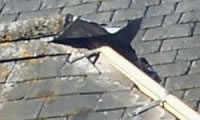
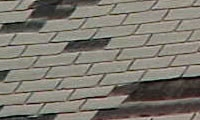
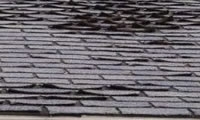
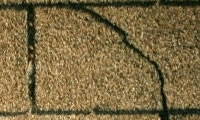
Missing Ridge Tiles
Blistered, curled or split shingles.
Loose or missing shingles or tiles.
Broken or loose shingles at the ridge lines and hip lines.
Loose nails. A loose nail means an open hole, which can cause leaks and subsequent water damage to your roof.
Exposed nails. These also can lead to leaks in your roof as the water seeps around the head of the exposed nails.
Dark patches on asphalt shingles and/or large amounts of granules in the rain gutters. This could mean that the granular coating of your roof is wearing away and needs to be replaced.
On a slate roof, dark patches could indicate mold , but are often just discolored places from trees dripping repeatedly on the slates. If you see dark patches, be sure to check the interior for dark or discolored drywall or other evidence of a leak before calling an inspector or contractor.
Sagging either on the ridges or in the center of the roof.
Rusty or corroded metal (flashing) and loose shingles in the valleys , plumbing vents or near chimneys. You may need to removed leaves and other debris before a proper inspection can be done. Remember that a lot of leaf debris in the valleys, plumbing vents, or near the chimney can cause problems with your roof if not dealt with promptly at the end of the season.
Rusty metal or loose shingles in locations where a vertical side of the house meets the roof .
Overflowing gutters or excess water pooling near the foundation of the house.
On a flat roof, look for blisters in the coating. If you want to fix them yourself, pop the blisters with a knife and coat them with roofing cement to prevent further damage.
Depressions near the vent pipe on a flat roof is another sign to look for. These depressions also can be filled in with roofing cement. Keep your eyes open for separations in the flashing, or clogged drains, as these are also signs of trouble for a flat roof.
Inside Roof Inspection Advice 
Roof Leak
Do you need a new roof? It can sometimes be tough to determine just why your inspector says a new roof is necessary, but there are a few simple signs to look for.
Continue the inspection from inside, where there is a whole new set of problems to look for. The obvious leak is not hard to miss, but there are warning signs you can look for that may help you stop a problem before it reaches the critical stage. These include:
• Sagging decking between the rafters.
• Outside light that can be seen from the attic. If you have a shake roof, this may not be a problem as shakes will swell and seal during the wet months. On any other type of roof however, seeing the sky through your roof is not a good sign.
• Signs of leaking in the attic. This could include dark spots in the wood, especially around vents, chimneys, and other hole to the roof, or stained drywall/ceiling tiles if your attic is finished.
• If you find a dark spot on your wood, test it to determine if it is old or a new problem. If the spot is still wet, or if it is soft when you press a screwdriver to it, the spot is a current problem. If it is dry and hard, the problem has already been taken care of and you do not need to worry more about it.
• Signs of water damage or leaking (usually in the form of water stains, or sagging ceilings)--this could be from either an active leak in the roof or to collected condensation caused by poor ventilation.
ROOFING IS MY JOB.....HONESTY IS MY PRODUCT